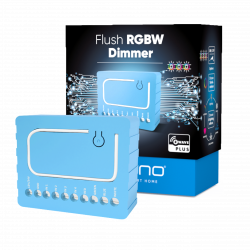Ningún producto
Precios con IVA incluído
Producto añadido correctamente a su carrito de la compra
Hay 0 artículos en su carrito. Hay 1 artículo en su cesta.
FIBARO RGBW Controller 2
FGRGBW-442
Nuevo
Este controlador RGB/RGBW puede controlar tiras de LED, LEDs RGB/RGBW y fuentes de luz de 12V o 24V. Además permite hacer muchas otras cosas en domotica Z-Wave
En Stock - Envío inmediato
- Eliminar de mis favoritos
- Agregar este producto a mis favoritos
- Imprimir
Características técnicas
| Tecnología Domótica | Z-Wave Plus |
| Característica | Dimmer |
Descripción
FIBARO RGBW Controller 2 es un controlador universal compatible con Z-Wave Plus.
Controlador RGB/RGBW.
El FIBARO RGBW Controller 2 utiliza la señal de salida PWM, lo que le permite
tiras de LED, RGB, RGBW, luces halógenas y otras luces resistivas.
cargas. También puede medir la potencia activa y la energía consumida por el
carga. Los dispositivos controlados pueden ser alimentados por 12 o 24V DC.
Las entradas soportan interruptores momentáneos/toggle y sensores analógicos de 0-10V, como sensores de temperatura, sensores de humedad, sensores de luz, etc.
Desata tu fantasía y expresa tu estado de ánimo con luz de colores! Con el Fibaro RGBW Controller 2 usted pinta su cuarto de baño con luz usando rayas LED, ajustadas a la temperatura del agua de su bañera. O haga que la luz de su casa se ponga roja tan pronto como se active un sensor de alarma. Hay 3 millones de colores a su disposición. Así que el único límite es tu imaginación.
Gracias al módulo de radio compacto, puede integrar las luces LED RGB y RGBW conectadas en su red Z-Wave. Con el mando a distancia, el smartphone o la automatización controlada por sensores puede conmutar y atenuar los LED y seleccionar cualquier valor de color.
Características:
Módulo de radio para la instalación de cajas de pared
Conmutador, atenuador y función de selección de color RGBW
Función de medición de energía
Tensión: 12 V o 24 V DC
Max. Salida: 6 Un solo canal, 12 A todos los canales de salida en total
Consumo de energía: < 0.3 W
Hasta 4 sensores analógicos (0-10 V) conectables (sensores no incluidos en la entrega)
Tecnología inalámbrica: Z-Wave Plus
Seguridad: S2
SmartStart habilitado
Dimensión: 42 x 38 x 18 mm
Información Ampliada Z-Wave (Inglés)
Descargue el manual desde aquí.
1. Power the device.
2. Set the main controller in (Security/non-Security Mode) add mode (see the controller’s manual).
3. Quickly, three times click the button.
4. If you are adding in Security S2 Authenticated, scan the DSK QR code or input the underlined part of the DSK (on the device label).
5. LED will start blinking yellow, wait for the adding process to end.
6. Successful adding will be confirmed by the Z-Wave controller’s message.
To add the device to the Z-Wave network using SmartStart:
1. Set the main controller in Security S2 Authenticated add mode (see the controller’s manual).
2. Scan the DSK QR code or input the underlined part of the DSK (on the device label).
3. Power the device.
4. LED will start blinking yellow, wait for the adding process to end.
5. Successful adding will be confirmed by the Z-Wave controller’s message
1. Power the device.
2. Set the main controller into remove mode (see the controller’s manual).
3. Quickly, three times click the button.
4. LED will start blinking yellow, wait for the removing process to end.
5. Successful removing will be confirmed by the Z-Wave controller’s message.
1. Press and hold the button to enter the menu.
2. Release the button when the device glows yellow.
3. Quickly click the button to confirm.
4. After a few seconds the device will be restarted, which is signaled with the red LED colour.
Use re- set procedure only if the primary controller is missing or inoperable.
Opiniones
Funciona estupendo
Conectado con el Fibaro HC3 y todo estupendo. Aún le falta la misma integración que tenía en el HC2, pero funciona muy bien.














